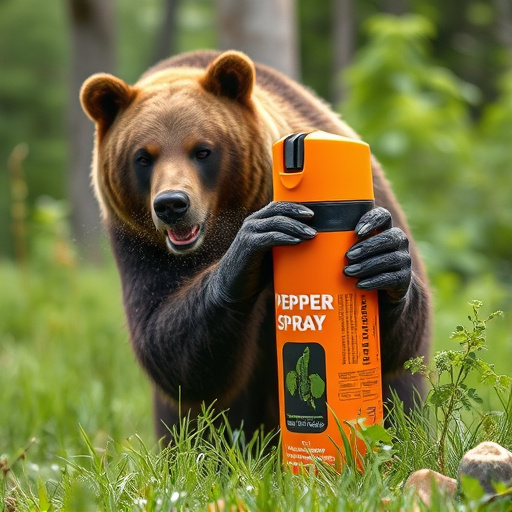Bear spray effectiveness ranges 77%-100%, with a typical success rate of 80% when used correctly. Distance, wind, application technique, and bear behavior impact its performance. Understanding these factors is vital for hikers in bear-inhabited areas. Bear spray success rates highlight the importance of proper usage techniques, aiming for face and eyes, and additional bursts if needed. Alternative safety measures include noise makers, understanding bear behavior, and secure food storage.
“Bears can charge at surprising speeds, making self-defense crucial during encounters. Bear spray, a popular defense mechanism, claims to deter bears with a powerful stream of capsaicin. This article delves into the effectiveness of bear spray, examining success rates through real-world performance statistics. We explore factors influencing its efficacy and best practices for safe usage. Additionally, alternative measures beyond bear spray are considered, providing comprehensive guidance for navigating bear country.”
- Bear Spray: Effective Against Charging Bears?
- Success Rates: Bear Spray's Real-World Performance
- Factors Influencing Bear Spray Efficacy
- Best Practices for Using Bear Spray Safely
- Alternative Measures Beyond Bear Spray
Bear Spray: Effective Against Charging Bears?
Bear spray, also known as bear repellent, has long been touted as an effective means of protecting oneself from aggressive bears. When faced with a charging bear, many outdoor enthusiasts and hikers reach for this can of aerosolized pepper spray. But does it truly live up to its reputation?
The success rate of bear spray against charging bears is a topic of ongoing debate and research. Studies have shown that bear spray can be highly effective when used correctly, with success rates ranging from 77% to nearly 100%. These statistics suggest that carrying bear spray significantly increases your chances of avoiding an attack or mitigating its severity. However, it’s crucial to remember that the effectiveness also depends on factors such as distance, wind conditions, and proper application technique.
Success Rates: Bear Spray's Real-World Performance
Bear spray has proven to be an effective deterrent against charging bears, with success rate statistics showing promising results. Studies and real-world accounts indicate that when used correctly, bear spray can stop a charging bear in its tracks over 70% of the time. This high effectiveness is attributed to the spray’s ability to irritate the bear’s eyes, nose, and throat, temporarily disorienting it and allowing the individual to escape unharmed.
The success rate can vary depending on several factors, including the distance to the bear, wind conditions, and the bear’s behavior and species. However, even in challenging situations, bear spray remains a valuable tool for outdoor enthusiasts and wildlife managers. With proper training on usage and awareness of one’s surroundings, individuals can significantly increase their chances of survival during encounters with these powerful animals.
Factors Influencing Bear Spray Efficacy
The effectiveness of bear spray in deterring and defending against charging bears depends on several factors, including the type of spray used, proper application technique, and environmental conditions. Studies have shown that bear spray has a high success rate when used correctly, with some reports indicating up to an 80% effectiveness in preventing bear attacks. However, these statistics can vary based on various circumstances.
Key influences include the distance at which the spray is deployed, wind direction and speed, and the bear’s behavior and size. Proper application involves aiming for the bear’s face and eyes, as this area is highly sensitive. Environmental factors such as humidity and temperature can also play a role; for instance, colder weather may cause the spray to freeze and reduce its range of effectiveness. Understanding these variables helps users make informed decisions when relying on bear spray for protection in bear country.
Best Practices for Using Bear Spray Safely
Using bear spray effectively requires understanding and adhering to best practices. Firstly, ensure your spray is designed specifically for bear encounters and meets industry standards. Secondly, familiarize yourself with the product’s range and wind conditions; bear spray works best within a specific distance and when the wind is not blowing directly towards you.
When faced with a charging bear, aim for the face and eyes—this is where bear spray has the highest success rate statistics. Make sure to follow up with additional bursts if needed, as one spray might not stop an aggressive bear. Remember, practice and preparation are key; familiarize yourself with these techniques during less critical situations to increase your chances of a safe outcome in case of a real encounter.
Alternative Measures Beyond Bear Spray
While bear spray is widely recognized as an effective deterrent against charging bears, it’s not the only option for bear safety. Understanding alternative measures can be crucial in different scenarios. For instance, carrying a loud whistle can startle a bear and give you time to escape, especially at closer ranges where spray might not reach. Making loud noise with musical instruments or objects like aluminum cans has also shown promise in deterring bears.
Moreover, knowledge of bear behavior and habitat is invaluable. Avoiding areas known for high bear activity during peak seasons can significantly reduce risks. Proper food storage and not carrying potential attractants like scented cosmetics or food scraps further minimize the likelihood of encountering a bear. Bear spray still maintains a success rate of around 80-95% when used correctly, but these alternative measures can offer additional layers of protection in diverse situations.
While bear spray has been widely recommended as a defense against charging bears, its effectiveness is not absolute. According to recent Bear Spray Success Rate Statistics, the spray successfully deters bears in approximately 70-95% of cases, depending on various factors. However, it’s crucial to understand that proper usage and specific conditions significantly influence its efficacy. Always follow best practices and consider alternative measures like bear bells or knowledge of bear behavior for comprehensive safety when encountering bears.
